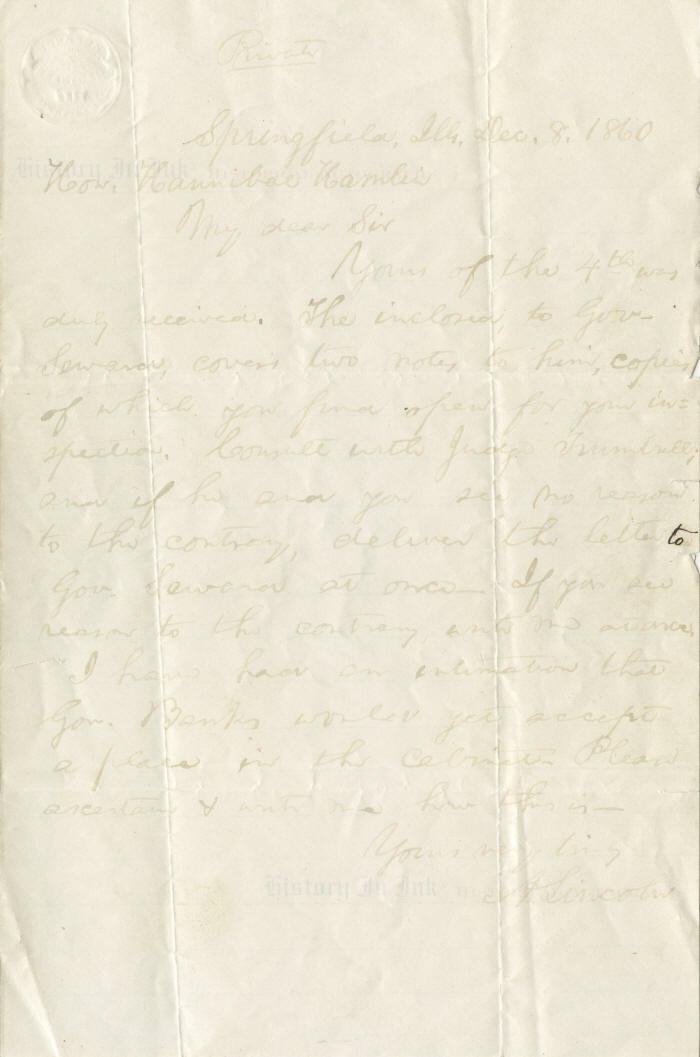2129501
Abraham Lincoln
Scroll down to see images of the item below the description
Lincoln, as President-Elect, asks Vice President-Elect Hannibal Hamlin
to deliver letters offering the highest cabinet post, that of Secretary of State,
to William H. Seward, Lincoln’s chief rival for the 1860 Republican presidential nomination
Abraham Lincoln, 1809–1865. 16th President of the United States. Important autograph letter signed, A. Lincoln, one page, 5¼” x 7 7⅞”, with integral leaf attached, on blind-embossed stationery, Springfield, Illinois, December 8, 1860.
It was by this letter, which he marked “Private,” that Lincoln set in motion the appointment of the most important and most powerful member of his Cabinet. Lincoln, who had been President-Elect for just over a month, asks Vice President-Elect Hannibal Hamlin to deliver two letters (not present), one formal and one much more personal, to offer the position of Secretary of State to New York Senator William H. Seward.
This letter has impeccable provenance. It was previously part of the renowned Forbes Collection. Collector Malcolm Forbes (1919–1990), the publisher of Forbes magazine, acquired this letter and Lincoln’s handwritten copy of one of his letters to Seward, which are discussed below, at Sotheby’s in December 1981. Copies of the original Sotheby’s listing and the Sotheby’s invoice to Forbes Inc. accompany this letter. The letter has also been published in 4 The Collected Works of Abraham Lincoln 147 (Roy P. Basler et al. eds., 1953).
Seward, one of the foremost politicians of the 19th Century, would become one of the most notable Secretaries of State. Historians have generally given him high marks. A vocal abolitionist, Seward served on the Senate’s Committee of 13 that unsuccessfully sought to find common ground and avert secession, and he later served as a delegate to the failed Washington Peace Conference in February 1861. It was Seward who exerted the most influence on Lincoln to tone down the rhetoric of his first inaugural address, particularly changing Lincoln’s ending question, “Shall it be peace or a sword?”, to a peroration of brotherhood that Lincoln massaged into what it ultimately became. Harold Holzer, Lincoln President Elect: Abraham Lincoln and the Great Secession Winter 1860–1861, at 442–45 (2008). Thus, Seward, more than anyone else, persuaded Lincoln to make his first inaugural address “more ‘pacific’ than Lincoln originally intended.” Id. at 439.
Once the Civil War commenced, Seward, as the new Secretary of State, worked to prevent foreign diplomatic recognition of the Confederacy. He encouraged foreign governments to prevent the smuggling of war materiel and goods to the Confederacy, and he worked with Charles Francis Adams, the American ambassador to the Court of St. James’s, to maintain British neutrality and prevent the construction of Confederate ships in Britain. The night of Lincoln’s assassination, Seward was also violently attacked in his home as part of a conspiracy to kill Lincoln, Vice President Andrew Johnson, Seward, and General Ulysses S. Grant to cut off the head of the federal government in aid of the Southern rebellion. Although severely wounded, Seward survived and continued to serve as Secretary of State under Johnson. He negotiated the 1867 Alaska Purchase from Russia, adding nearly 600,000 square miles of territory to the United States, ending Russian presence in North America, and giving the United States a strategic presence in the Pacific Rim.
In this letter, Lincoln writes, in full:
Private
Springfield, Ills. Dec. 8, 1860.
Hon. Hannibal Hamlin
My dear Sir
Yours of the 4th was duly received. The inclosed [sic] to Gov. Seward, covers two notes to him, copies of which you find open for your inspection. Consult with Judge Trumbull; and if he and you see no reason to the contrary, deliver the letter to Gov. Seward at once— If you see reason to the contrary, write me at once.
I have had an intimation that Gov. Banks would yet accept a place in the Cabinet. Please ascertain & write me how this is—
Yours very truly
A. Lincoln
Within a day after his election, Lincoln had decided whom he wanted in the Cabinet. Doris Kerns Goodwin, Team of Rivals: The Political Genius of Abraham Lincoln 280 (2005). He hoped to include members from various factions of the nascent Republican Party, which had been formed only some six years earlier by a consortium of former Whigs, anti-slavery Democrats, and former Free Soilers who opposed the expansion of slavery into the western territories. A master politician, Lincoln turned to his major rivals for presidential nomination. They included Salmon P. Chase of Ohio, Simon Cameron of Pennsylvania, Edward Bates of Missouri, and—first and foremost—Seward. Id.
Seward had long been the frontrunner for the nomination. But he was too vocal an abolitionist, while Lincoln, who also opposed slavery on moral grounds, nevertheless sought only to prevent its expansion in light of the Kansas-Nebraska Act and agreed that the federal government was powerless under the Constitution to abolish slavery where it already existed. Lincoln thus was viewed as was more moderate and likely more electable. On the third ballot at the 1860 Republican National Convention in Chicago, Lincoln seized the vote from Seward and was nominated as the party’s presidential candidate. Maine Senator Hamlin was nominated for Vice President.
Seward was both disappointed and bitter over losing the nomination to Lincoln, but he nevertheless worked hard for Lincoln during the 1860 campaign. Still, he had publicly said that he did not want to be Secretary of State. Lincoln nevertheless dispatched Hamlin to ask Seward whether he would accept the position. Hamlin first approached Seward’s colleague, New York Senator Preston King. But on December 4, 1860, Hannibal wrote Lincoln to say that King preferred that he “should confer directly” with Seward, which Hamlin said seemed to him to be “the appropriate method” but which he knew would “be equivalent to a tender of a place in your Cabinet should he desire it.” Hamlin added: “My impression is he will not desire a place in your Cabinet, but he may.”
In response, Lincoln wrote this letter to Hamlin, acknowledging Hamlin’s letter “of the 4th” and enclosing the two letters to Seward, together with copies of them for Hamlin to read. He instructed Hamlin to confer with Illinois Senator Lyman Trumbull, with whom Lincoln had a difficult relationship but whom he nevertheless courted, particularly on appointments, and to deliver the letters to Seward immediately “if he and you see no reason to the contrary.”
Hamlin, who reported that he and Trumbull “could see no reason why the letter should not be delivered,” talked with Seward in Washington, D.C., on December 10. He asked whether Seward would indeed reject appointment as Secretary of State. Seward recoiled: “If that is what you have come to talk to me about, Hamlin, we might as well stop here. I don’t want the place, and if I did, I have reason to know that I could not get it; therefore let us have no more talk about it.” But Hamlin pressed him, telling Seward that “before you express yourself to others as plainly as you have done to me, let me present you with this letter from Mr. Lincoln.” Goodwin, supra, at 284.
Hamlin then gave Seward the first letter, which formally conveyed Lincoln’s intention to nominate him. At that, Seward “trembled” and seemed “nervous.” Id. Then Hamlin gave him the second letter, which was “brilliantly designed to soothe Seward’s ego.” Id. In that letter, which was marked “Private & confidential,” Lincoln spoke of Seward’s “position in the public eye” and his “integrity, ability, learning and great experience,” which he said combined “to render it an appointment pre-eminently fit to be made.” He wrote:
Private & confidential
Springfield, Ills. Dec. 8, 1860
My dear Sir
In addition to the accompanying, and more formal note, inviting you to take charge of the State Department, I deem it proper to address you this. Rumors have got into the newspapers to the effect that the Department named above would be tendered you, as a compliment, and with the expectation that you would decline it. I beg you to be assured that I have said nothing to justify these rumors. On the contrary, it has been my purpose, from the day of the nomination at Chicago, to assign you, by your leave, this place in the administration. I have delayed so long to communicate that purpose, in deference to what appeared to me to be a proper caution in in the case. Nothing has been developed to change my view in the premises; and I now offer you the place in the hope that you will accept it, and with the belief that your position in the public eye, your integrity, ability, learning and great experience, all combine to render it an appointment pre-eminently fit to be made.
One word more. In regard to the patronage, sought with so much eagerness and jealousy, I have prescribed to for myself the maxim, “Justice to all”; and I earnestly beseech your co-operation in keeping the maxim good.
Your friend and
obedient servant
A. Lincoln
Seward, his face was “pale with excitement,” called the letter “remarkable” and said that he would “consider the matter.” Id. at 285. Hamlin reported to Lincoln that he was “not able to tell you what will be the final determination, tho the Gentleman has said decidedly that he would decline all place. But as I wrote you before he may reconsider his opinions.”
Seward “kept Lincoln dangling.” Holzer, supra, at 143. On December 13, he wrote Lincoln a letter in which he said that he was honored to be selected but needed time to consider whether he had “the qualifications and temper of a minister, and whether it is in such a capacity that my friends would prefer that I should act if I am to continue at all in the public service.” His words suggested a concern that serving as Secretary of State might damage his future chances for the presidency. But there was more: He wanted to help select Lincoln’s remaining cabinet officers, the most important of whom he thought should also, like himself, be former Whigs. Id. at167; Goodwin, supra, at 283, 285. His principal advisor and emissary, powerful New York Republican Thurlow Weed, who visited Lincoln in Springfield, Illinois, tried but failed. Holzer, supra, at 165–70. Finally, on December 28, Seward accepted the position in a brief letter to Lincoln. He later tried to back out two days before the inauguration, but Lincoln ignored his request. Id. at 432–34.
In this letter, Lincoln also asks Hamlin about the possible nomination of Massachusetts Governor Nathaniel P. Banks to a Cabinet position. Hamlin effectively vetoed Lincoln’s suggestion that Banks might fill a New England spot in the Cabinet. On December 14, Hamlin wrote that Gideon Welles or John A. Andrew would be better suited for the appointment—that although Banks was “a man of decided ability,” nevertheless “he is wonderfully cold and selfish,” and “I do not hear him talked of by our N.E. friends.”
As noted, this letter and one of the handwritten copies that Lincoln enclosed with it to Hamlin sold at Sotheby’s in 1981.
This letter is generally clean and bright. The ink is faint but still quite legible. There are intersecting folds, one of which goes through the left leg of the “A” in Lincoln’s signature, and there are some minor edge tears. The letter is in fine condition.
Given Seward’s importance to Lincoln during the campaign, during the preparation of his first inaugural address, and during the Civil War, this is an exceptionally important letter in the field of Lincolniana. It belongs in the finest of Lincoln or presidential collections.
Unframed.
Click here to see more Presidents and First Ladies autographs.
The light color is how the letter and signature actually appear.
The darker color has been enhanced for readability.








